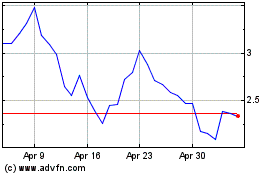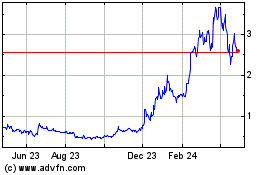theBlock Research Pins Stacks as a Key Player in the BTC Network
July 12 2022 - 6:59AM
NEWSBTC
Bitcoin is widely considered to be the world’s leading
cryptocurrency. However, builders can use this technology to
develop powerful applications, protocols, products, and services.
Several ecosystems emerged on top of Bitcoin over the years, and
Stacks continues to note tremendous growth. The Ongoing Evolution
of Stacks Many people may recall Stacks under its former name of
Blockstacks. It is a smart contract layer for Bitcoin tethered to
the Bitcoin blockchain through a cross-chain consensus mechanism.
The hash of the Stacks state is embedded into every Bitcoin network
block. More importantly, Stacks is not limited to Bitcoin’s scaling
– or lack thereof – as it relies on a different approach to process
transactions. Under the Stacks hood, the network relies on two
types of blocks: Anchor blocks: used to tether Stacks to Bitcoin
Microblocks: powering applications requiring high throughput and
low latency. One of the emerging partners through Stacks is Hiro,
an organization focused on building Bitcoin applications. They,
too, see merit in further scaling Stacks through Hyperchains and
increasing the throughput even further. Hiro proposes using trusted
federated hyperchains to evolve into a trustless hyperchain
solution. Stacks Adoption Increases Rapidly The approach by Stacks
immediately gained traction since launching its smart contracts in
2021. That resulted in a Total Value Locked increase following the
introduction of native-BTC swaps and support for Non-Fungible
Tokens. The current Total Value Locked in Stacks hovers near $100
million, most of which resides in the StackSwap DEX and token
launchpad. Another growth factor, as outlined in the recent
TheBlock research, is the number of projects building Stacks
to unlock more Bitcoin-oriented potential. The smart contract layer
is leveraged by Alex, Gamma, Arkadiko, HeyLayer, Zest, Xverse,
Planbetter, Block Survey, Provico, Byzantion, GoSats, and Moon.
That confirms overall interest in this technology keeps rising, and
more developers want to experiment with Bitcoin-capable smart
contracts. Moreover, the position of Stacks has been solidified by
Trust Machines that recently a massed a warchest of $150M. The
Trust Machines team wants to become the “ConsenSys of Bitcoin”,
which may sound rather ambitious to onlookers. However, it aims to
explore all opportunities brought to the Bitcoin ecosystem, and the
initial focus will shift to the Stacks ecosystem. Statistics-wise,
the network notes a healthy uptake on smart contracts, NFTs, and
other transactions. The coinciding growth of smart contract
deployment and NFT events is to be expected, although there will be
other use cases for these contracts in the future. The Push
Continues Although Stacks has seen tremendous growth since its
launch, there is more work to do. One focal point is introducing
developer incentives. Development for and on Bitcoin will only
advance when more people are interested in exploring the available
opportunities. So together with GSR, OKCoin, and Digital Currency
Group, the Stacks Foundation announced a $165 million incentive
dubbed Bitcoin Odyssey. That fund is designed to provide financial
support for applications and builders who drive Bitcoin adoption.
Another crucial catalyst to consider is how developers achieve
peace of mind when building on Stacks. One of its core benefits is
maintaining a design approach that doesn’t require changes to the
Bitcoin protocol. That also extends to applications getting
“stuck”, as they can resolve those issues quickly and seamlessly.
Stacks (COIN:STXUSD)
Historical Stock Chart
From Mar 2024 to Apr 2024

Stacks (COIN:STXUSD)
Historical Stock Chart
From Apr 2023 to Apr 2024
